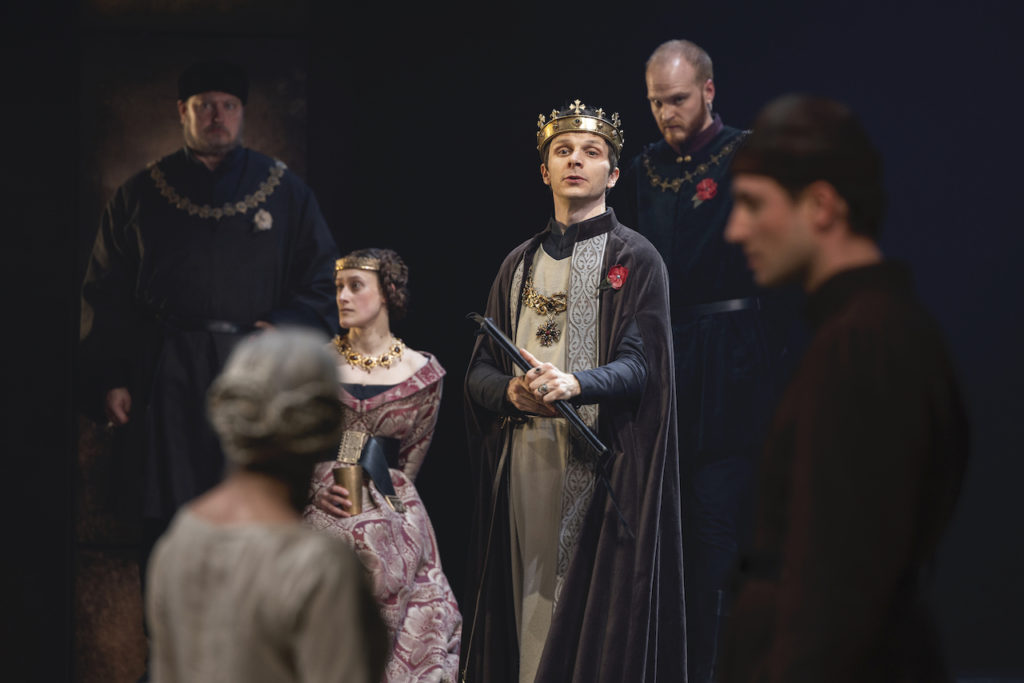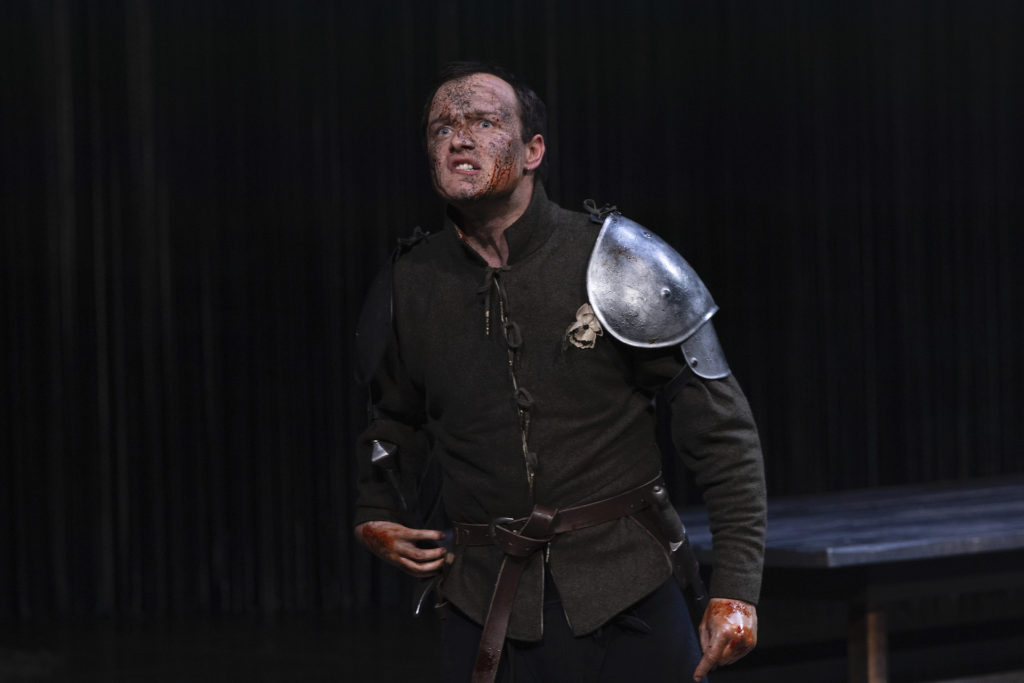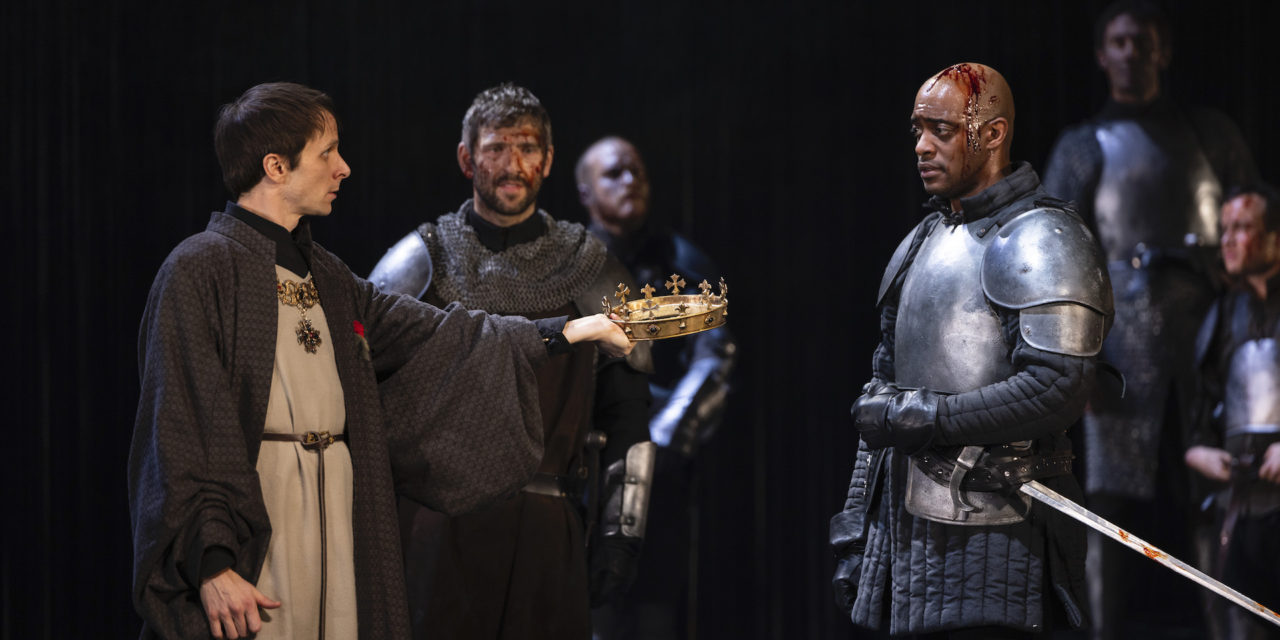
Power and the lust for power are the mingled themes of these rarely performed but gripping early Shakespeare histories. Last year the RSC streamed a rehearsal room version of the first part of the trilogy. Parts Two and Three, given the additional titles ‘Rebellion’ and the ‘Wars of the Roses,’ both directed by Owen Horsley and ingeniously adapted from the lengthy full texts, are now being given well-deserved exposure as part of this summer’s repertoire on the Stratford main stage.
In ‘Rebellion’ we watch and listen in horror as the English nobles scheme and conspire around their gentle monarch, drawing in the common people and swapping allegiances with crude opportunism. By ‘The Wars of the Roses’, the divisions between the houses of Lancaster and York have exploded into bloody civil war. The ensuing slaughter is relentless and brutal – the production even provides a trigger warning lest anyone should be unduly distressed by the level of onstage violence. Henry is ineffective in the face of naked ambition and carnage. An avowed pacifist, he was born in the wrong century – the medieval king had to be both ruler and warrior.
Both plays are bleak in outlook and the weak central character offers little hope of redemption in this world. But this being Shakespeare, there are moments of great pathos and humanity and it is these which lift the play beyond political machinations and violence.
Stephen Brimson Lewis offers us a bleak yet flexible design of grey stone and weathered wooden platforms. This functions effectively as throne room, palace, street and battleground. At the same time, a huge translucent backscreen shows greyscale projections of past and present action. Well-camouflaged onstage camera operators allow for close-ups of critical moments across this backcloth so that that every audience member can witness the fine facial expressions at moments of high drama. The dark, atmospheric score for percussion string and brass by Paul Englishby accentuates the high tension that is sustained throughout the play.
Henry V1 Part Two has the largest cast list of any of Shakespeare’s plays and the RSC have taken the opportunity to include non-professional actors from their two outreach programmes, Next Generation, for school students, and Shakespeare Nation, from their work with 12 regional partner theatres. The visiting performers become rebels, followers of Jack Cade, the populist leader who persuades them that he is the rightful heir to the throne. Thus ordinary people play ordinary people and they appear wonderfully authentic, whether scrambling down ropes from the flies or surging in from the wings.
In a piece with so many strong roles it is hard to single out individual performances. But in the midst of so much anger and belligerence, Mark Quartley shines out with his subtle portrayal of King Henry. Playing a man who is both weak and unassertive, he nevertheless holds the stage with his quiet slender presence and engaging humanity, moving from doubt and uncertainty to full scale breakdown as the consequences of his inaction unfold.

His Queen Margaret is a complex and intriguing character, not all bad but hard to like. Minnie Gale’s exuberant physical performance grabs the audience’s attention from the start, but it is her culminating scene in which she collapses weeping on the body of her dead son that captures our hearts

Among other fine performances it is worth noting Nicholas Karimi as Warwick, Oliver Alvin-Wilson as York, and Richard Cant as Gloucester. The most interesting debut must go to Arthur Hughes as Richard Duke of Gloucester. In June he will be appearing on the same stage as Richard III.

If you have the stomach for a six-hour Shakespeare immersion it is well worth seeing both productions on the same day. The uncut version would have lasted four hours each. But at the time of their invention, Shakespeare’s plays were living changing creations, written and rewritten as the actors and writer made changes to the text. Even now it is unclear how much of these two plays involved collaboration with Thomas Nashe and Christopher Marlowe.
Thus there are alterations throughout, including the loss of the final scene in Part Two. Instead of York’s triumph, ‘Rebellion’ gives the final word to King Henry, to great effect. By contrast, the closing section of ‘The Wars of the Roses’ remains very much as in the original, Henry VI part 3, though the technical effects of the production gives an uncomfortable foretaste of darkness to come. While Edward IV, formerly the Duke of York, frolics in his court, on the back-lit screen Richard Duke of Gloucester cradles his infant nephew, the heir to the Yorkist throne and future prince in the Tower, in his murderous arms.
★★★★★ Ros Carne 21st April
Photo credit: Ellie Kurttz


